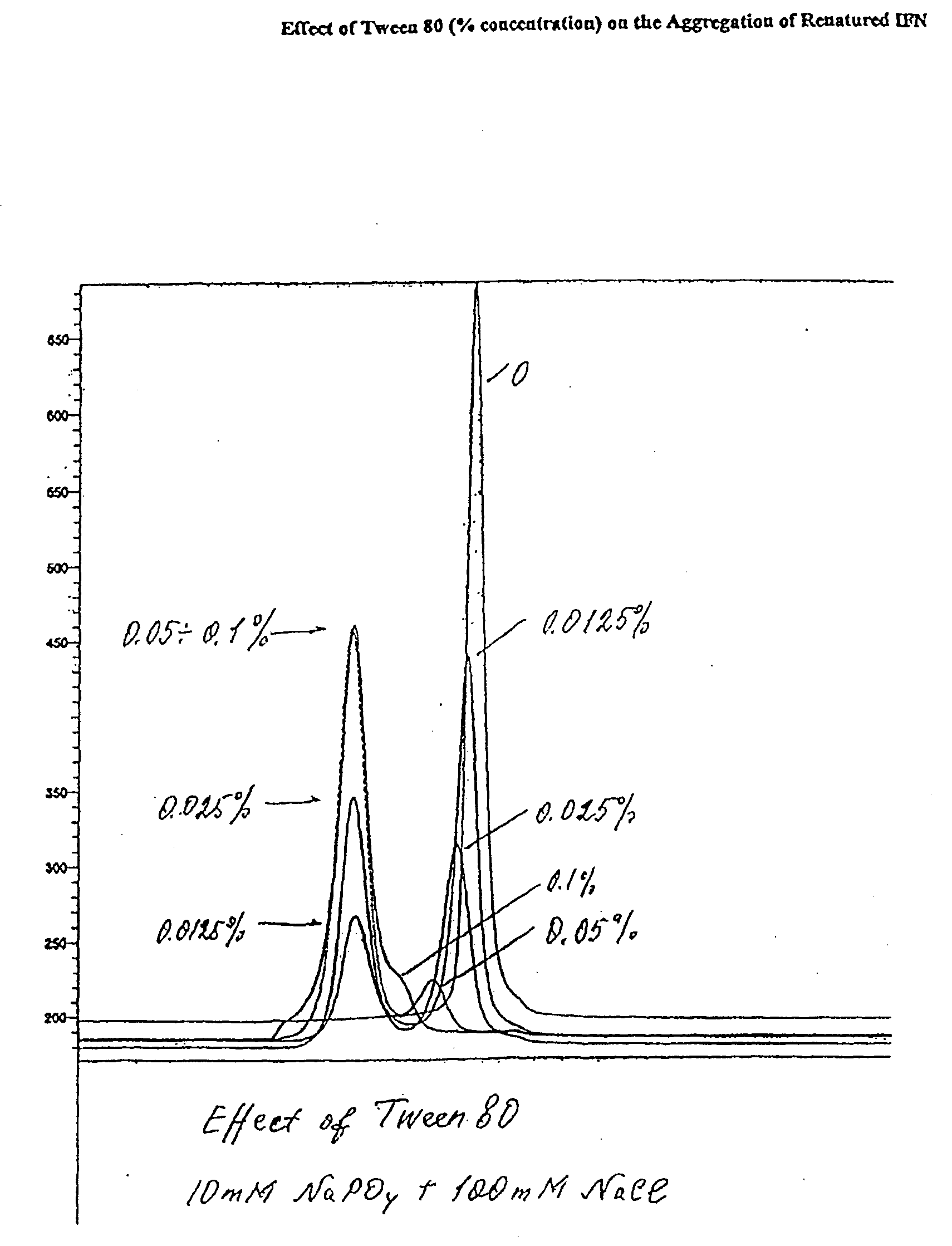Methods of protein purification and recovery
a protein and purification technology, applied in the field of biochemical engineering, can solve the problems of difficult purification of interferons, difficult isolation of interferons from natural sources, and difficult clinical testing and evaluation of interferons' therapeutic value, and achieve the effect of improving the refolding of proteins
- Summary
- Abstract
- Description
- Claims
- Application Information
AI Technical Summary
Benefits of technology
Problems solved by technology
Method used
Image
Examples
example 1
Preparation of IFN-β
[0045]IFN-β for use in these experiments was produced in E. coli essentially as described in the first several steps of purification set forth in U.S. Pat. Nos. 4,462,940 and / or 4,816,400. That is, transformed bacteria were used to produce IFN-β; the host cells were concentrated, and their cell walls disrupted. The IFN-β was then prepared according to the methods of the present invention following preparation of a purified IFN-β pool.
[0046]The basic procedure was as follows:[0047]1. Precipitate IFN-β from purified IFN-β pool using ethanol. Six parts of purified IFN-β pool are used for four parts of ethanol. This step yields more than 80% of the interferon as a pellet that can be centrifuged.[0048]2. The pellet is then dissolved in 8 M guanidine HCl to a solution of about 10 mg / ml protein. This solubilization is rapid; the small amount of SDS present is not solubilized and is removed by filtration.[0049]3. The resulting guanidine HCl solution is then diluted into ...
example 2
Dilution Parameters for Guanidine Hydrochloride Step
[0050]Initial experiments were carried out to determine the optimal dilution parameters for the guanidine hydrochloride dilution step. A small-scale experiment that measured relative yields was carried out as outlined in Table 1; best results were obtained above pH 4.0 and below 0.8 M guanidine hydrochloride after dilution. The concentration of the interferon-beta monomer was determined using sizing HPLC with a 400 mM glycine pH 3.0 buffer. The results in Table 2 and a typical set of chromatograms in FIG. 1 show that although non-covalent multimers were obtained at lower pHs, monomeric interferon-beta was obtained at pH 5.0 and above.
TABLE 1Relative Yield After Dilution of Guanidine HCl (8M)IFN (~10 mg / ml) Estimated by HPLCGuanidine HCl Concentration After Dilution10 mM BufferpH0.2 M0.4 M0.8 M1.6 MGlycine322.111Sodium acetate41312.762Sodium acetate568683330Sodium citrate679624342Sodium phosphate782714148Tris HCl899834038
TABLE 2Perc...
example 3
Yield of Guanidine Dilution Step
[0051]The process was scaled up to evaluate the yield of the guanidine dilution step. The results in Table 3 show that a 41% to 57% yield can be obtained with a forty-fold dilution at pH 6 to 8 with a final protein concentration of about 0.15 mg / ml. SDS concentrations in samples tested were less than 10 micrograms per milligram of IFN.
TABLE 3Refolding Recovery from 8 M Guanidine HCl (40x dilution)10 mM BufferpH[IFN] mg / ml% YieldSodium citrate60.1241Sodium phosphate70.1757Tris HCl80.1552
PUM
| Property | Measurement | Unit |
|---|---|---|
| pH | aaaaa | aaaaa |
| pH | aaaaa | aaaaa |
| pH | aaaaa | aaaaa |
Abstract
Description
Claims
Application Information
 Login to View More
Login to View More - R&D
- Intellectual Property
- Life Sciences
- Materials
- Tech Scout
- Unparalleled Data Quality
- Higher Quality Content
- 60% Fewer Hallucinations
Browse by: Latest US Patents, China's latest patents, Technical Efficacy Thesaurus, Application Domain, Technology Topic, Popular Technical Reports.
© 2025 PatSnap. All rights reserved.Legal|Privacy policy|Modern Slavery Act Transparency Statement|Sitemap|About US| Contact US: help@patsnap.com



